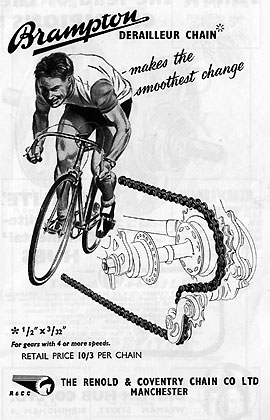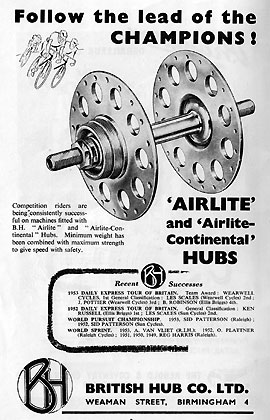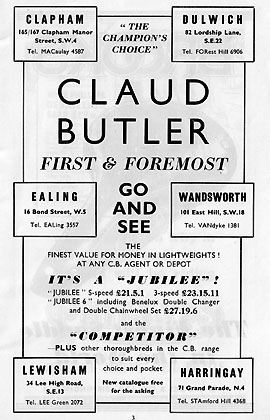|
 The 1954 Tour of Britain - Part 3 The 1954 Tour of Britain - Part 3
Credit: Daily Express Tour of Britain Preview
Dateline: 5-Jun-1954
Marathon on Wheels
H H England, Editor of Cycling sets the scene for the fourth Daily Express Tour of Britain
TWO thousand five hundred years ago, Marathon was the site of a great battle with the Persian enemy standing 10 to 1 in overwhelming numbers. An Olympic champion of those days first ran 150 miles for Spartan aid, and then the 20-odd miles to Athens with news of the victory. There he fell dead!
The modern Olympic endurance test is 26 miles. On a bicycle, which gears-up man's physical endeavours, the cyclist can ride five times as far and nearly five times as fast as the man on foot for the same energy output.
In the Tour of Britain the competing giants of the wheel are riding Marathon distances, multiplied five times, on almost every stage of the 13-day contest which starts in Great Yarmouth on June 6th and, surmounting the Peaks, the Pennines. the Cheviots. South Scotland's Beattock and Westmorland's Shap (where the railway has a spare mammoth engine to help pull the trains over this height!). Then into Wales with a mountain time trial (each rider alone and unpaved instead of in a group) reaching the 1,000-ft. level, and on secondary and unclassified roads, and so over Wenlock Edge and Blackdown Hill of the Devon-Somerset border, repeated on the return journey to embrace the South Coast area, and finally to London on June 19th.
THE 1951 'EXPERIMENT'
Marathon indeed! Thirteen races in fourteen days (there is a rest day at Glasgow after the fifth stage) with a total mileage of 1,461 and two of the days each demanding over 150 miles of riding with the great hill ranges thrown in. Only the time trial, the eighth stage. is as low as 42 miles (and as high as a mountain!). Nine of the 13 stages are over 100 miles in distance apiece.
What of the race itself? There are Tours de France, Belgium, Italy. even Luxembourg and, of course, all on bicycles. The Tour de France is legendary. A race of tremendous ballyhoo and publicity, that also tests out the greatest roadmen in the world over its 3,000 miles, including Alpine and Pyrenean heights of many thousands of feet.
If the Tour de France is lacking a feature in the minds of its promoters, it is that Britain is not represented amongst the teams. Britain cannot be represented without worthy riders; and worthy riders cannot be developed without testing opportunities for racing.
The Daily Express provided those opportunities in 1951. The first Tour of Britain was a race of experiment and great daring. It had all the teething troubles in the world, yet it succeeded, with a Scotsman, Ian Steel (Viking), as the winner—winning, let me add, because he won into Glasgow and then Wouldn't let go! Next-1952. Team work, the very breath of massed-start cycle racing, was still not fully developed. But the race gained character, and a lone rider, Ken Russell (Ellis-Briggs) of Yorkshire, was the winner.
In 1953 the Tour of Britain took on its stature. It was subscribed to by all the cycling organizations in agreement and all cyclists of goodwill. There was a foreign invasion of quality, and for three stages they dominated the race. But team work came into its own. Those teams are here again this year—besides France, Italy and Belgium there are, for Britain, teams sponsored by B.S.A., Hercules, Wearwell, Viking, Ellis-Briggs, Pennine and Gnutti-Cinelli, all well-known cycle and accessory makers.
Last year it was the B.S.A. team that brought Gordon Thomas through to victory. It was the Hercules man Dave Bedwell who dominated the mountains, and it was the consistent riding of the Wearwell boys who kept so close to the leaders as to win the team race.
HIGHLIGHTS OF THE ROUTE
I haven't counted the counties through which the Tour of Britain travels, but three countries are its terrain. Nine times at least the riders reach mountain heights of over 1,000 feet.
Where will you go to watch this race of the giants? Last year's popular agony height was Holme Moss (on the Lancashire-Yorkshire border) at 1,725 feet. and it comes on the third day this year. Or the day before, when both Manchester and Sheffield cyclists will enjoy exciting watching at the appropriately-named Snake Pass (1,680 ft.). There is Carter Bar (1,371 ft.) at the Scottish Border or Shap, long and gruelling. reaching a second height of 1,304 ft.
If you are a seaside cyclist you'll watch the start from the bloater town of Great Yarmouth, or go to Whitley Bay, near Tyneside, to see the end of Stage 4 and the start of the next assault. The Westerners have Weston-super-Mare or the next day at Torquay, or a day later at Bournemouth.
The run down from Shap to Morecambe is breathless, and you may enjoy the strange experience of seeing the riders get there before their motor followers. Even the judges nearly missed the arrival last year! The Welsh fans have Prestatyn and Llandudno, and the most interesting and fortune-changing time trial in between.
The Tour is a race all right, and men have to be men to stay the course, let alone win it. But it's a tour of Britain in the other sense, too: East Anglia; the Peaks; Harrogate, the birth of the Cyclists' Touring Club; the Great North Road and Hadrian's Roman Wall. The wild Cheviots and Scotland. The Land's End to John o' Groats route in reverse over Beattock and Shap, and via romantic Gretna Green. The Duchy of Lancaster and the Principality of Wales. Llangollen, where the Centenary Club was born in 1939, 100 years after the invention of the bicycle: Wolverhampton, where road massed-start racing was first introduced, and so through the Civil War country and the Regency West to the county of cream and lace. Finally, through Wessex, where Britain learned to be a kingdom, and Dorchester, where our pre-history had a large part of its beginnings. Thence to the Capital City of London.

VALUE OF THE RACE
Man's earliest civilizing invention was the wheel, and in the final stage of this Tour of Britain, it leads to the birthplace of the latest of man's toys and services—Alexandra Palace, where television became a reality and a rival even to riding a bicycle. yet .. .
Britain's bicycles, proved good the world over for 85 years, are being tested by this race to show more than ever that they are supreme, whether for racing. pleasure riding or utility.
The Tour of Britain is a pivot of popularity that is giving cycling a new boost. For it must be remembered that this magic instrument which makes the greatest of all Marathons possible, with distances of more than 100 miles in a stride, and pedalled speeds of 25-30 m.p.h., gives of its magic also. in reverse. If you wish only to go short distances at slow speeds the 'geared-walking' on a bicycle makes the effort five times easier!
The sport itself could not promote a Tour of Britain. It is therefore to enterprises, such as the Daily Express, and the cycle makers who develop and train the teams, that we owe this exciting sporting occasion.
<<Part 2>> | Part 3 | Part 4 Results>>
|